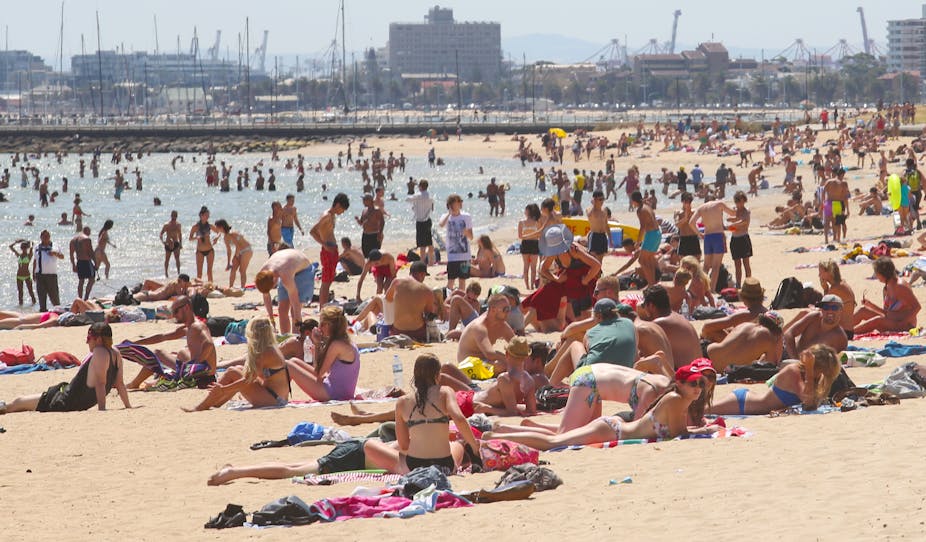Heatwaves are one of the most important climate-related risks for Australians. Sometimes called the “silent killers”, they cause the greatest number of deaths of any natural disaster type in Australia, and have significant impacts on infrastructure, agriculture and biodiversity. As the climate continues to warm, heatwaves are becoming hotter, longer and more frequent.
The extreme heat in Melbourne that frazzled the Australian Open tennis tournament and the record-breaking heat in large areas of Queensland this summer remind us of the risks that heatwaves pose. Hot on the heels of the “angry summer” of 2012/2013, this summer’s heat is part of a longer-term trend towards hotter weather.
Heatwaves on the rise
The Climate Council’s latest report – “Heatwaves: Hotter, Longer, More Often”, which we co-authored – delivers four key findings.
First, climate change is already increasing the likelihood and severity of heatwaves across Australia. Second, heatwaves have widespread impacts including increased deaths, reduced workplace productivity, damage to infrastructure such as transport and electricity systems, mortality of heat-sensitive plants and animals, and stress on agricultural systems. Third, record hot days and heatwaves are expected to increase further in the future. And finally, limiting future increase in heatwave activity requires urgent and deep cuts to greenhouse-gas emissions.
Since 1950, the annual number of record hot days across Australia has more than doubled, and both maximum and minimum temperatures have increased by around 0.9°C. Over the past decade, the frequency of record hot days has been more than three times the frequency of record cold days. The hottest area-averaged national maximum temperature ever recorded was 40.3°C on 7 January 2013, and extreme temperature records were broken in every state and territory throughout the course of the 2012/2013 summer.
Almost all of Australia has experienced a lengthening of the heatwave season, with the first heatwave event occurring much earlier than it did 60 years ago. The intensity of heatwaves, as measured by the temperature of the hottest day (the peak of the heatwave), is also increasing.
This summer, Australians again endured record-breaking, extreme heatwaves and hot weather. On 3 January, Queensland experienced its hottest area-averaged day on record and for the week ending 4 January, average maximum temperatures were a staggering 8°C or more above normal in the southern inland part of the state.
Record high maximum temperatures occurred over 8.8% of Australia during the first four days of January, including 17% of New South Wales, 17% of the Northern Territory, 16% of Queensland and 8% of South Australia. On 2 February, Adelaide reached a new February record of 44.7°C, some 15°C above average.
The global picture
Heatwaves are also on the increase worldwide, with severe heatwaves affecting many countries and regions in the last 10-15 years. One of the most severe was the European heatwave of July and August 2003, with France and Switzerland particularly affected. This heatwave was followed in 2010 by an even more intense and widespread heatwave, which scorched large swathes of Eastern Europe, including western Russia, Belarus, Estonia, Latvia, and Lithuania.
Long-term temperature reconstructions show that these were the hottest summers that Europe has experienced for at least 500 years. North America has also experienced several recent heatwaves, with a major heatwave affecting the state of Texas in July 2011 and a heatwave covering a greater area of the country in 2012.
Diverse impacts
The impacts of heatwaves are surprisingly large and diverse. The Bureau of Meteorology has dubbed heatwaves “the most under-rated weather hazard in Australia”. While heatwaves do not result in obvious violent effects on the landscape, unlike many other weather-related disasters such as high-intensity storms and bushfires, their impacts on health, the workplace, infrastructure, agriculture, and the environment are serious, costly and long-lasting.

While the 2009 Black Saturday bushfires killed more than 170 people, the preceding heatwave killed double this figure. The economic burden of heatwaves is significant, through the demand placed on emergency services, infrastructure stress and breakdown, and agricultural losses. For example, as temperatures soared during the 2009 heatwave, the Basslink electricity cable between Tasmania and Victoria reached maximum operating temperature, causing the system to shut down and resulting in widespread blackouts in Melbourne.
Plants and animals are also susceptible to extreme heat events, with flying foxes, birds and rainforest marsupials being particularly vulnerable. Marine heatwaves can trigger coral bleaching events, affecting large areas of reefs. Bleaching events on the Great Barrier Reef have occurred repeatedly since the late 1970s, with none reported before then. These bleaching events have contributed to the observed 50% loss of coral cover in the Great Barrier Reef over the past 30 years.
The case for decarbonisation
As greenhouse gases continue to rise in the atmosphere, heatwaves will continue to worsen.
According to the Intergovernmental Panel on Climate Change’s 2012 Special Report on Extremes and last year’s release of the first part of the IPCC Fifth Assessment Report, it is virtually certain that hot extremes will increase and cold extremes will decrease through the century compared to the current climate. It is also very likely that the length, frequency and/or intensity of heat waves will increase over most land areas around the globe.
This is the critical decade for action. Global emissions are still rising and Australian emissions are yet to make a decisive turn downwards. Despite the promising developments in low-carbon technologies and energy-efficiency measures, there is not yet widespread acceptance in Australia of the urgent need to decarbonise our economy and implement policies to facilitate a decarbonised future. This challenge must be met if we are to minimise the risk of worsening heatwaves and other extreme events for ourselves, our children and grandchildren. It’s time to get on with the job.
The Climate Council is a crowdfunded body that advises the Australian public on climate change. You can read its Heatwave Report here.

